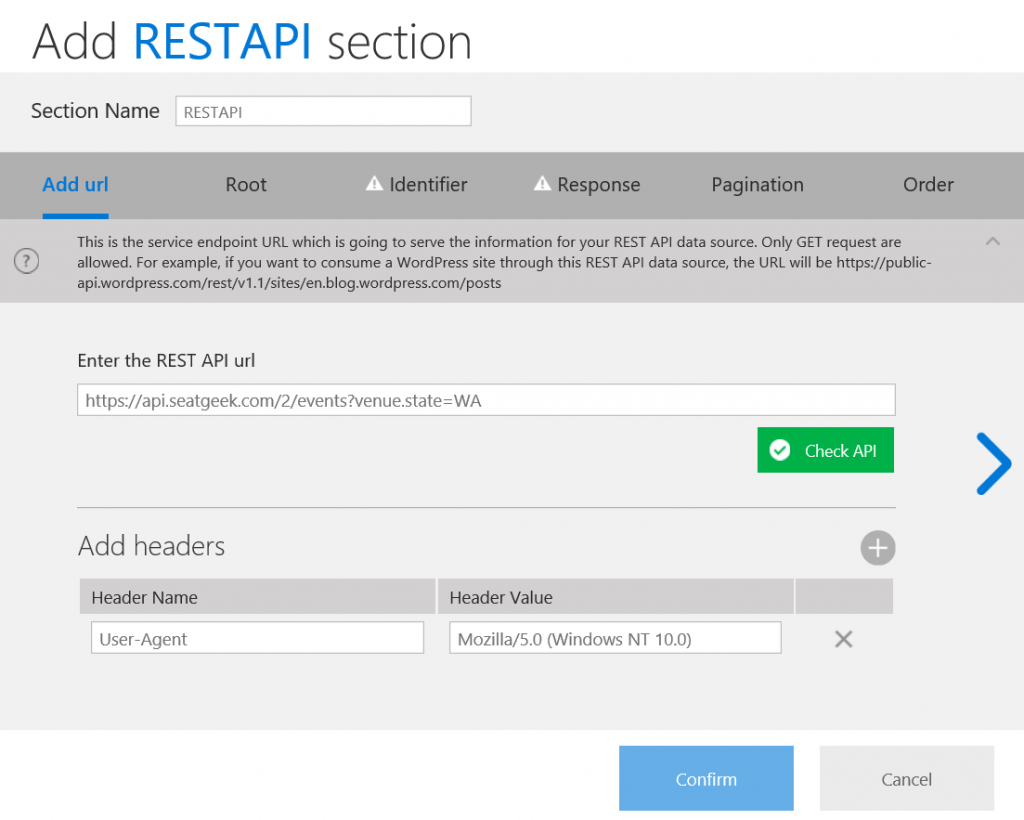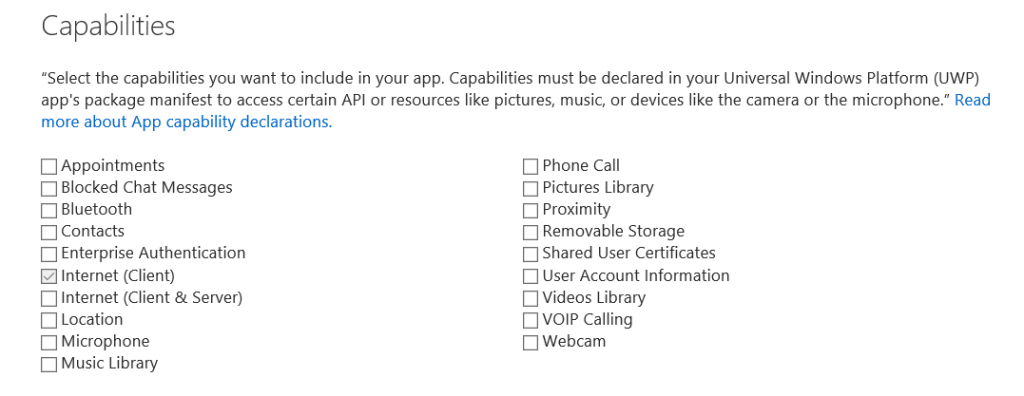This massive update also provides a bit of insight into where we want to take Windows App Studio going forward. We spent a lot of time this year thinking about how we can provide the best value to you through this tool, and we came to the conclusion that helping you bring the wealth internet services into your UWP apps (with no coding!) and giving you multiple outlets to share your apps is the best place to start.
Here at Windows App Studio, we have the philosophy that anyone should be able to create an app, and that coding knowledge shouldn’t necessarily be a barrier to that. Creating documents on the computer was far more complex when the technology was introduced decades ago, but now it’s easier than ever (especially with Office365) and the use cases for documents are plentiful to the point where everyone has reasons to make them. Apps, especially Universal Windows Platform apps, should enjoy that same future. What was once complex should become easy and the use cases of apps should become far broader than they are today.
Today’s release represents an early step in our promise to you to bring the best of the world of apps to you, in an easy and fast way, so you can create with the minimal limits possible. Check out the new release here.
The New REST API Data Source
The major feature we’re releasing today is a REST API Data Source, which is one the most requested features in the history of Windows App Studio. Much like the current RSS Data Source, this feature is open ended, meaning you can connect it to almost any open REST API service available on the internet. REST APIs are the backbone of how data gets passed around the web. If these are new concepts to you, an easy way to think about it is that APIs (Application Programming Interfaces) let different pieces of software talk to one another and REST (Representational State Transfer) is an architecturally structured way of “packaging” those data communications.
For the first version of this release, we’re supporting GET commands for REST APIs (meaning it only pulls information) and have support for headers, as well. This data source is more complex than others, so we have a post with instructions on how to use it posted on our Windows App Studio blog, which you can find here.
There are REST APIs available for almost any type of data and almost every major service has an API for developers. For example, if you want to add event/concert listings to your app, you can use an API from a service like SeatGeek or SongKick to pull in event information for a region or filter you specify. The app you generate with this data will stay up to date each time it’s opened and makes a new request for data.
We plan to do a lot more work to this feature going forward to make it more powerful and a lot easier to use and provide easier integrations for the most popular REST APIs. The current state of the feature is definitely more complex than it will be going forward, but can be used by a non-developer right now without any major issues. So play around with it, look up API documentation of the service you’re integrating to make sure the requests are formatted correctly, and remember that you can’t truly break anything, so experiment freely. J
Hosted Web App Capability Declarations
Hosted Web Apps created with Windows App Studio are quite popular as it’s the fastest and easiest way to bring your web app to UWP. Today’s release expands on the feature and lets you declare capabilities of your app, letting you can take advantage of the Windows 10 OS features with your server-side code so your web app can act like a native Windows UWP. You can now enable things like Live Tiles, Notifications, Cortana, and a lot more.
This release also includes a massive amount of smaller improvements and features. Since this is already a marathon of a blog post, here are the highlights:
Tool Improvements
Simulator Improvements: Redesigned detail pages, Carousel & Slider View.
Ordering & Paging: Configuration Wizards in Edit Section to allow users to configure ordering and paging in all data sources.
Dark & Light Themes: Revised and improved.
Generated App Improvements
New Shell Control: Improved navigation and nav pane.
New Detail Pages: Improved layouts, better reading and content display taking advantage of HTML Block.
New About page: Improved the About page.
Performance improvements: General improvements for apps. Reduced memory and increased loading speed.
Carousel & Slider View: Updates to these components in generated apps.
Pagination & Infinite Scroll: Allows loading of more content from data sources, removing the fixed number of items (forty) retrieved previously.
Ordering: Allows ordering of the content as established in the app configuration. This also leads to a better experience in Live Tiles (if you have a Live Tile based on a collection ordered by a date field, when you add a new row it will appear in the live tile).
Open Source Library and Control Improvements
The Windows App Studio Libraries have seen healthy adoption since we announced them at //build. We hit the first major milestone of merging a pull request from a member of the Windows App Studio community. The update improved the RSS Data Source so it can now properly handle the “yandex:full-text” property in feeds which are popular in Russia and other countries. Other library improvements are the following:
HtmlBlock: Added a new control to our XAML library that transforms HTML and renders it as XAML, which improves the readability of HTML content in the generated apps as well as the overall application performance.
InfiniteScroll: Created a new control to allow apps to make pagination for a rich user experience.
Animated GIFs: Included support for Animated GIFs in our ImageEx control.
Carousel Redesign: Improved experience and better UX integration in carousel control.
Slider View: The older small carousel has been improved and got a name change for differentiation
REST API Data Source: The new data source is now in our libraries. This is a general purpose data source able to retrieve content from any REST API service. This data source allows ordering and paging.
Data Sources Ordering & Paging: All data sources now support Ordering & Paging.
Data Sources Language aware.
Other Things
Unfortunately, we have a bit of bad news this release as well. Due to policy changes by Instagram, we were forced to remove the Instagram data source. They no longer want their users’ content accessed outside of their 1st party apps without explicit permission, so they shut off the capability of other apps to consume Instagram content if the apps do not get prior approval. Sadly, this means that all current implementations of the Instagram data source no longer work and should be removed from your apps and projects.
We hope that you love the new features in this Windows App Studio release and we can’t wait to keep up the work and take this tool to the next level. For us to do that best, we need your help. So please let us know your thoughts and requests on the forum and User Voice, and if you’d like to contribute code to the Windows App Studio libraries, please do! You can find the libraries on our GitHub Page.
Thanks for reading and happy app building! We can’t wait to see all the creative things you’ll make.


